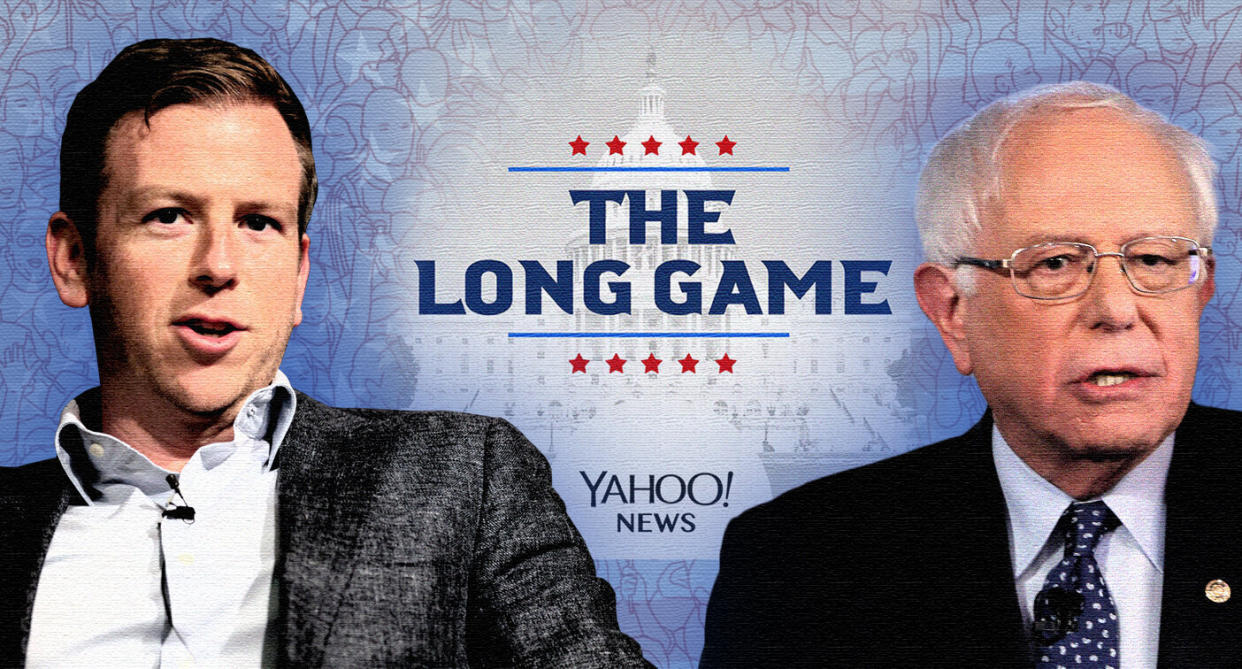'Fresher options' may replace Bernie Sanders as preference of young voters

Bernie Sanders may have captured the hearts of young voters in 2016 and be leading them now, but one observer of youth politics thinks that that advantage may evaporate.
“His appeal to young people in 2016 was conditional on who he was running against. … If you thought Hillary [Clinton] was boring, unexciting, cautious, timid, a flip-flopper, Bernie was the vehicle,” said Peter Hamby, host of the weekly Snapchat political show “Good Luck America.”
“There are younger, fresher options," Hamby said in an interview with the Yahoo News podcast “The Long Game.”
Sanders is leading among young voters in the most recent polling, with 29 percent of 18-to-29-year old likely voters telling Harvard University’s Institute of Politics in a March survey that Sanders was their first choice for the Democratic nomination for president in 2020. Former Vice President Joe Biden was the first choice for 18 percent.
But 20 percent were undecided, and that’s part of the reason that Hamby said younger voters may end up gravitating toward a different candidate. A Monmouth survey of Iowa voters in early April showed former South Bend Mayor Pete Buttigieg, who is 37, at 12 percent with 18-49 year olds, compared to Biden’s 16 percent, and Sanders’s 18 percent.
Hamby, a former CNN reporter, has become a close observer of changing approaches to communications among a more connected generation. His Snapchat show is viewed by an audience of roughly 2 million young people, he said, all of whom watch it on their phones.
“Bernie kind of seems like he’s running back to 2016 right now,” Hamby said, though he noted that Sanders is more in tune with the Democratic base on issues like racial justice and immigration. “It’s still a different campaign than it was last time and young people are open to new faces and polls show that.”
Hamby said that between “Good Luck America” and his regular column for Vanity Fair, “some days I feel like I inhabit two completely different worlds.” The majority of the Snapchat audience is 13 to 24 years old, while the Vanity Fair audience and the twittersphere in which political conversation takes place skews older.
The Snapchat show brings “news to audiences and eyeballs that are increasingly not getting it. That is a signal challenge of the media, to reimagine formats for people whose eyeballs are distracted by other things,” he said. “And then in the same day I’ll write an article for Vanity Fair that people talk about on Twitter.”
Twitter’s elite-driven conversation often creates an insularity that leaves media and political insiders out of touch with average people, Hamby said.
“We and our political community kind of live in a different universe than the one that a lot of our society lives in. … Power elites in the media and politics … need to understand a little bit better that a lot of people just aren’t reading and watching them, or listening to them, and they have to figure out ways to meet viewers, listeners and voters where they’re actually voting,” Hamby said.
Hamby said that reaching new, younger audiences is an “existential challenge” for legacy media companies.
“Most people are now getting their news signals through texts and chat and social media. I can’t tell you the last time I literally went to a homepage to get news,” he said. During interactions with news editors in the recent past, Hamby said, he has been “shocked at the lack of literacy around distribution, around product, around daily habits that normal people have.”
Similar rules apply for politicians, Hamby said. When it comes to the 2020 field, “attention today is the No. 1 currency in our politics, like it or not.”
That’s something that Trump figured out in 2016, generating press coverage through what Nate Silver called a “perpetual attention machine” that was always producing some new outrage for cable TV to spin into a segment and for online news outlets to generate clicks.
Trump capitalized on the symbiotic relationship that exists in media today, where politicians gain influence through providing media companies with audience share and revenue. And so far in the 2020 Democratic primary, candidates who have broken through the cluttered field — like Buttigieg and former congressman Beto O’Rourke — have followed a similar playbook.
O’Rourke created the impression of perpetual motion on the campaign trail, and was the hot candidate of the moment until Buttigieg overtook him, in part by granting interviews to virtually every reporter who requested one.
The real test for these upstart candidates will be to maintain their place in the spotlight without resorting to the kind of outrage tactics that fueled Trump’s candidacy, or some other form of gimmickry.
_____
Read more from Yahoo News:



